Rabri Recipe (Rabdi)
Updated: August 30, 2022, By Swasthi
Rabri also known as Rabdi is a North Indian traditional sweet dish made with full fat milk, sugar, cardamoms and nuts. It is served as a dessert or along with Malpua, Gulab Jamun, Jalebi and Poori. Rabri tastes very delicious, creamy & is full of flavors from the cardamoms and saffron. Making rabri at home does take some time & needs patience but the end results are worth the effort.
About Rabri
Rabri is a dessert made by simmering full fat milk until it turns thick and layers of cream are formed. It is then sweetened and flavored with cardamoms, rose water & saffron.
The process of making rabri is similar to Basundi, however rabri is more thicker and condensed for longer than for basundi.
There are 2 ways of making rabri. The first method is to simmer milk until it reduces to 1/3 of the original quantity. During the process of simmering, layers of milk cream formed on top is moved to the sides of the pot & stuck.
These layers are lastly loosened and added back to the pot which gives a great texture to rabdi. It is then flavored & garnished with blanched nuts.
The other method of making rabri is to simply keep simmering the milk and keep stirring without sticking the cream to the sides. Depending on the kind of milk, you will get smooth to slightly grainy texture in your rabri.
The first picture in this post is made following this second method. I made a large batch of rabri a few months ago, to serve with malpua. I also poured some to moulds and froze to make kulfi.
You can also make rabri in a much simpler way by just adding some nut powder, thandai masala powder, almond paste, condensed milk or even milk powder. These are less common ways but these methods cut down the cooking time a lot & rabri made this way tastes delicious too.
Sometimes I make it following the short cut method with nuts. I have shown this method in my shahi tukda post.
What to eat with rabdi?
Rabri can be eaten on its own as a chilled dessert with lots of nuts garnished over it. It is also served with jalebi, gulab jamun, malpua & even with puri.
More Sweets recipes,
Gulab jamun
Kalakand
Kaju katli
Rasgulla
Rasmalai
Gajar ka halwa
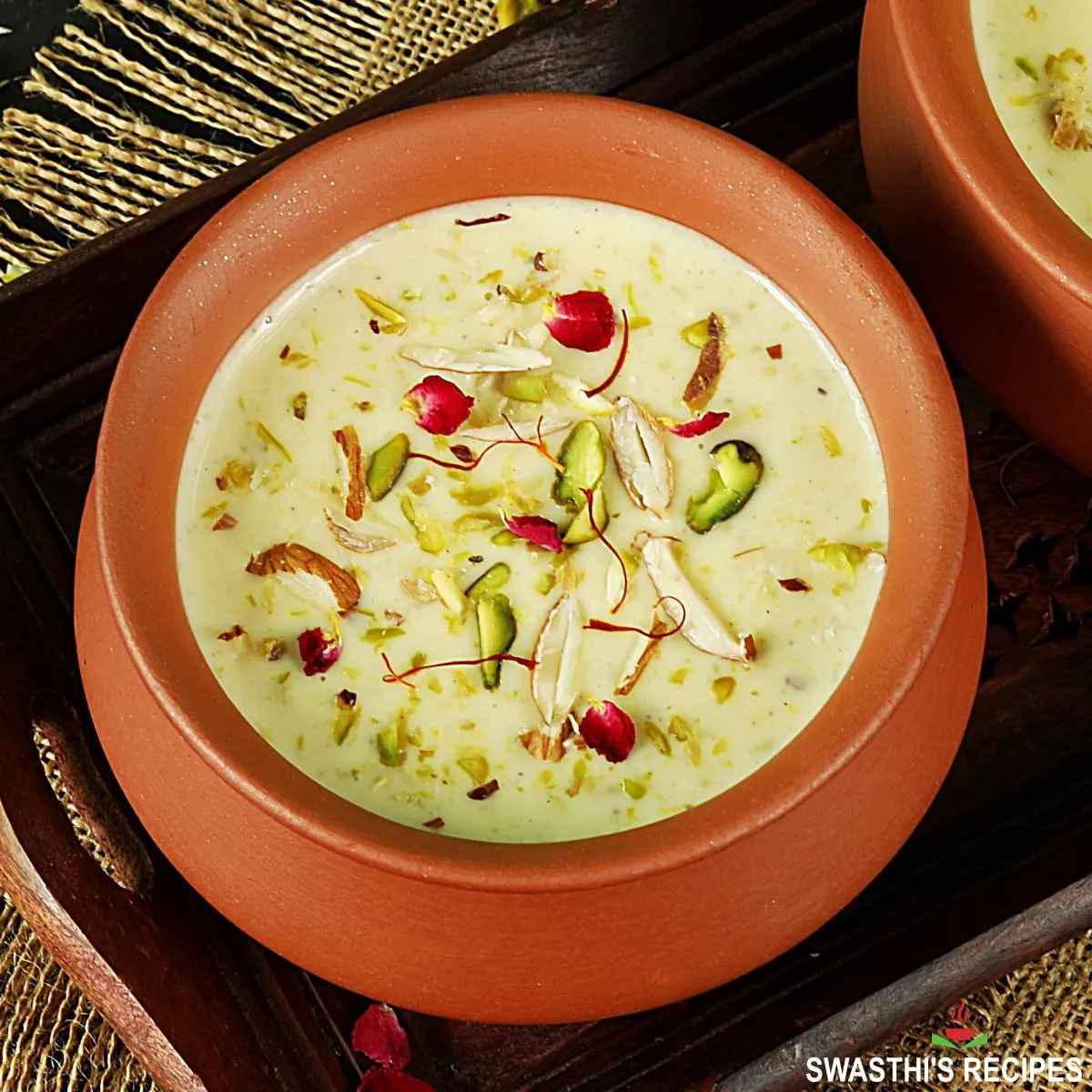
Photo Guide
How to Make Rabri (Stepwise Photos)
Preparation
1. Rinse or grease a wide heavy bottom pot. Pour milk & bring it to a boil on a medium flame. Greasing helps to prevent the milk fats being scorched at the bottom of the pot. A wide pot quickens the process of condensing the milk.
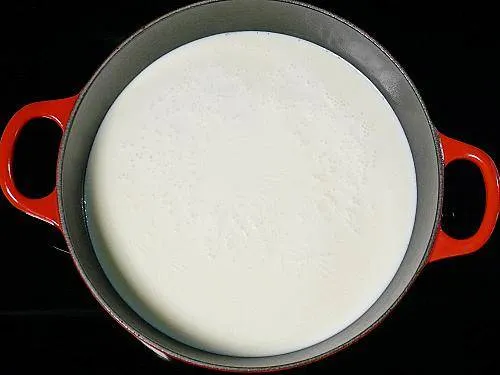
2. While the milk heats up, bring 1 to 2 cups of water to a boil. Switch off the stove and add nuts. Leave them in the water for 10 minutes.
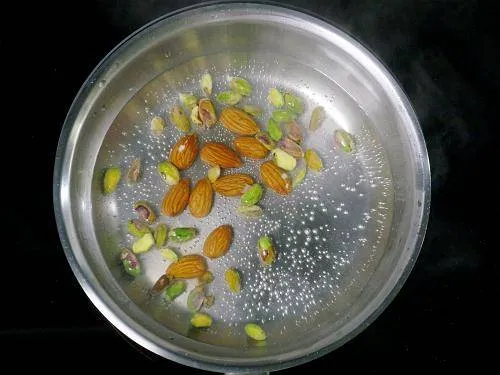
3. Later rinse them and peel the skin. Chop them to desired sizes.
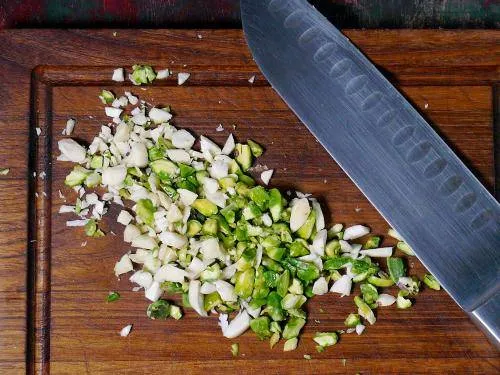
4. When the milk turns hot, transfer 2 to 3 tbsps hot milk to a small bowl. Add saffron to it and soak . You can also add it directly to the pot of milk later.
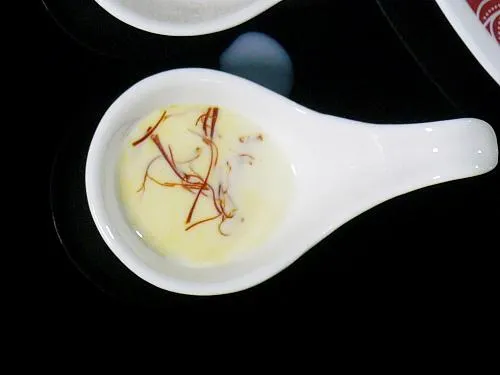
Make Rabri
5. Keep checking the milk. Every time a layer of cream forms, gently move it towards the sides of the pot.
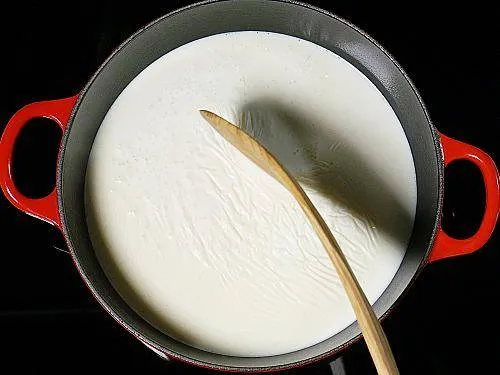
6. Stick it to the sides of the pot.
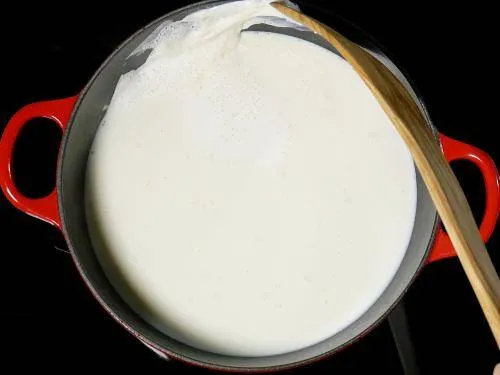
7. Stir the milk at the bottom to prevent the fats getting scorched. This 2 step process of sticking the layers of cream to the sides of the pot and then stirring milk at the bottom should continue till the milk reduces to half the original quantity.
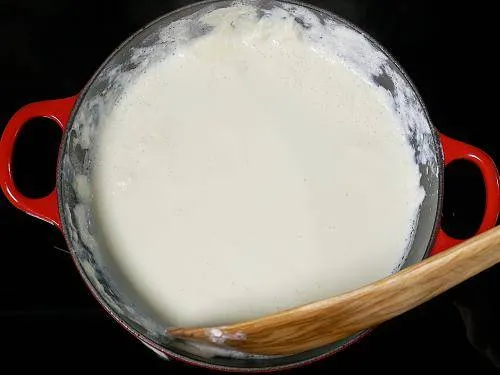
8. After simmering the milk for about 30 minutes, 6 cups of milk reduced to 3 cups. The timing may vary depending on the kind of utensil used and the stove or the intensity of heat.
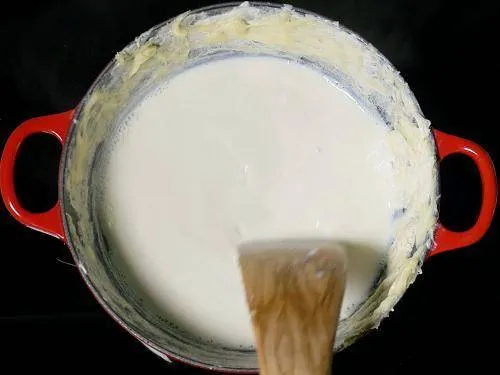
9. Add sugar. You can add as little or more as you want.
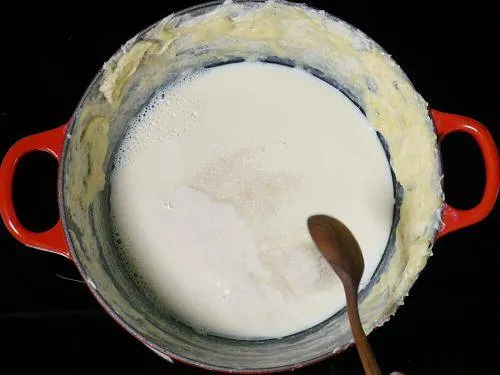
10. Then add saffron soaked milk, cardamom powder & rose water (optional).
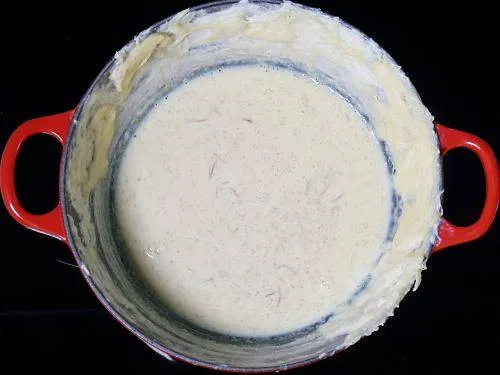
11. Begin to scrape the sides with the help of a wooden spoon. If the cream has dried up, pour some hot milk (from the pot) over the cream so it softens and comes off quickly.
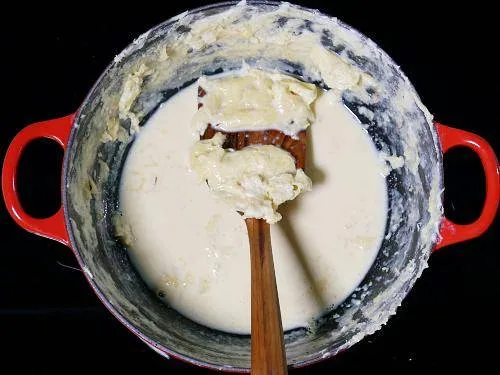
12. Continue to simmer stirring until the milk reduces to 1/3 of the original quantity or until it thickens a bit more. At this stage you can also see the color of the milk changes and a nice aroma begins to waft.
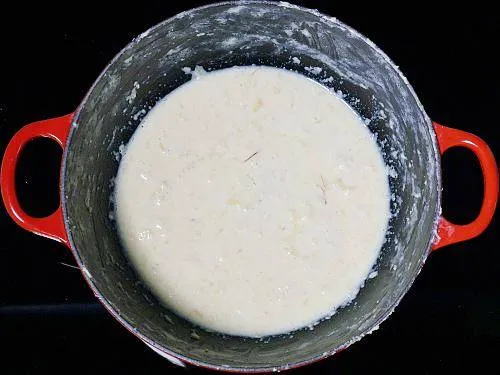
13. Add nuts and turn off the heat.
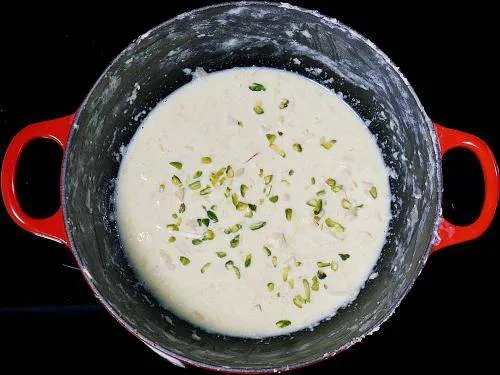
14. Chill rabri & then garnish with nuts. Serve with malpua, gulab jamun or jalebi. We personally love to rest rabri in clay pots for a few hours for that unique flavor.
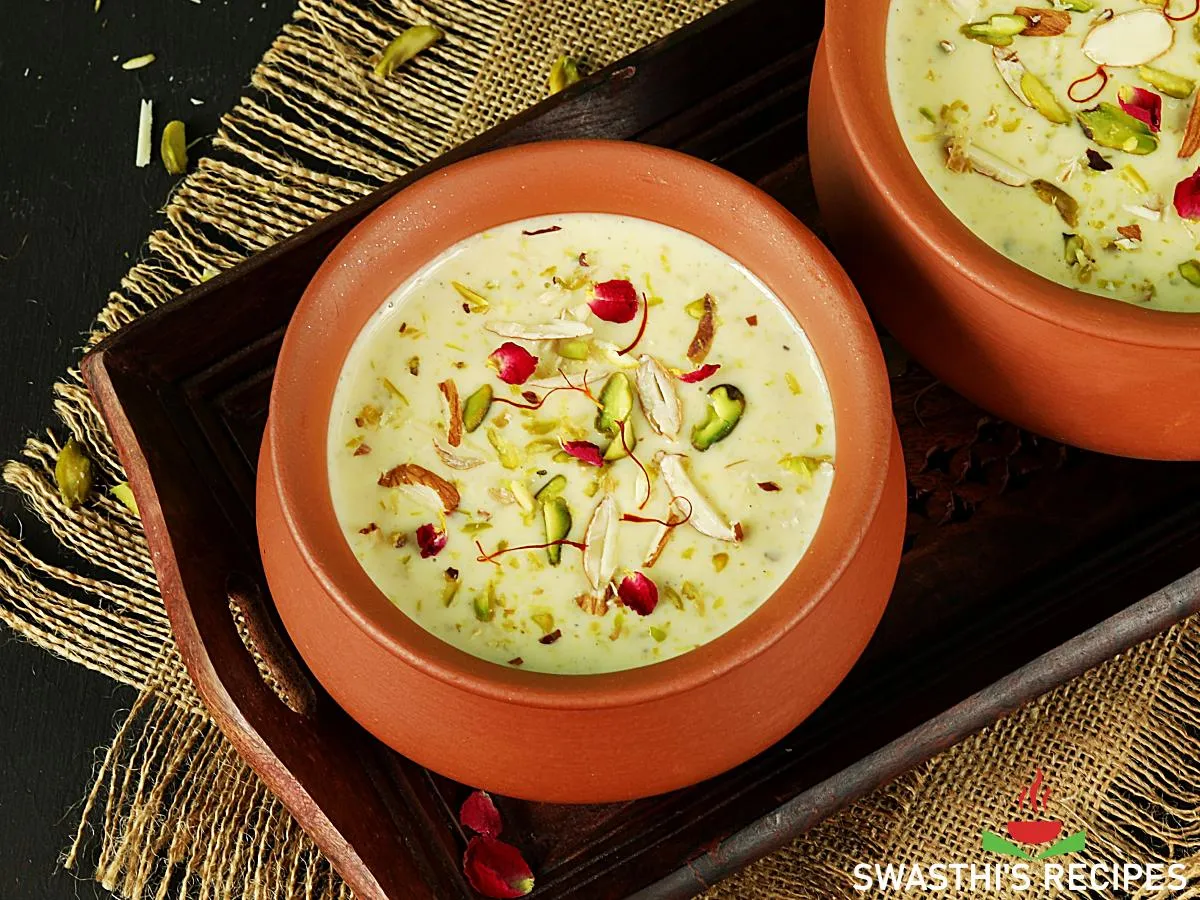
Pro Tips
1. Buffalo milk is best for making rabri as they are high in fat and thick layers of milk are formed easily. If you live in a place where it is not available, you can use cow milk just like the way I did it.
2. Avoid using cast iron pots to make rabdi as there is a high chance of the milk getting scorched at the bottom. A heavy bottom steel pot works well.
3. After making this for several years, I have found a wide steel pot to be the best. If you have a steel pressure pan, you can use that as well (without the lid).
4. If you want to make rabri with layers, then avoid non-stick pot as the layers won’t stick to the sides.
5. Follow the second method to make rabri without layers of cream. For the ingredients use the same as mentioned in the recipe.
Recipe Card
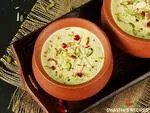
Rabri Recipe (Rabdi)
For best results follow the step-by-step photos above the recipe card
Ingredients (US cup = 240ml )
- 1½ liter full fat milk (6 cups)
- 4 to 5 tablespoons sugar (adjust to taste)
- ½ teaspoon cardamom powder
- 10 strands saffron (kesar) (optional)
- 1 teaspoon rose water (or kewra water) (optional)
- 10 almonds
- 15 to 20 pistachios
Instructions
Preparation
- Grease or rinse a heavy bottom pot and pour milk to it.
- Bring it to a boil then reduce the flame to low. Let the milk simmer until it reduces approximately to half the original quantity (to 3 cups).
- While the milk simmers, bring 1 cup water to a boil in a small pot. Add almonds and pistachios.
- Turn off the heat and rest the nuts until the skin loosens (for about 10 to 15 mins). Drain them and peel the skin. Chop them finely and keep aside.
- Transfer 2 to 3 tablespoons of hot milk from the pot to a small bowl. Add saffron strands and leave them to soak.
How to Make Rabri
- If you do not want to have layers of cream in your rabdi, you can skip this step. After simmering the milk for a while, a layer of cream forms on top of the boiling milk. Gently move that to the sides of the pot and stick up. (check the step-by-step pictures above or video)
- Next stir once to prevent the milk from getting scorched at the bottom.
- Continue to simmer the milk, slide the layer of cream to the sides of the pot every time it forms and repeat sticking it up to the side. Stir again once. This process of sliding and sticking to the sides should happen every time a layer of cream forms until the milk reduces to half the original quantity. I.e 3 cups in this case.
- Do not forget to stir at the bottom every time you slide the cream.
- When the milk reduces to half, add sugar and then scrape off the layers of cream from the sides of the pot. If the milk cream has dried up, pour some hot milk (from the pot) over the sides. This will soften it and loosen. Add it back to the milk.
- Simmer until the quantity reduces to 2 cups. Add nuts, saffron milk, cardamom powder & rose water. Turn off the heat.
- Chill rabri and garnish with nuts just before serving. It can be served with gulab jamun, malpuas & jalebi.
Notes
- You can bring milk to a boil on a medium to medium high flame. But once it turns hot, ensure the milk boils at low flame until the last step.
- If you do not want layers in your rabdi, you may skip sticking the cream to the sides of the pot.
- Use a heavy bottom pot and avoid cast iron pots as milk scorch very fast.
Video
NUTRITION INFO (estimation only)
© Swasthi’s Recipes
Rabri recipe originally published in 2016 Dec. Republished in 2020 October.
About Swasthi
I’m Swasthi Shreekanth, the recipe developer, food photographer & food writer behind Swasthi’s Recipes. My aim is to help you cook great Indian food with my time-tested recipes. After 2 decades of experience in practical Indian cooking I started this blog to help people cook better & more often at home. Whether you are a novice or an experienced cook I am sure Swasthi’s Recipes will assist you to enhance your cooking skills. More about me
Follow Swasthi’s Recipes


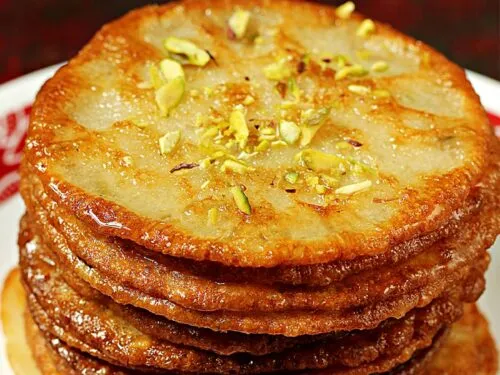
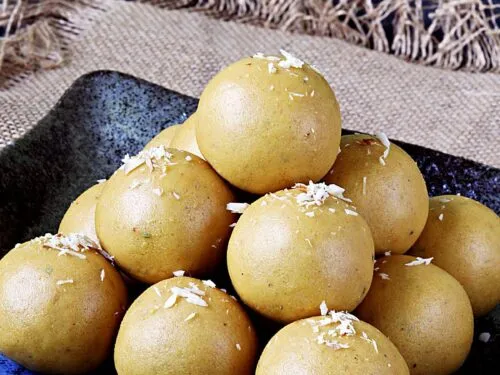
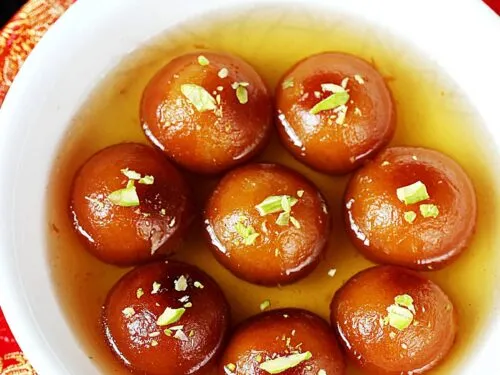
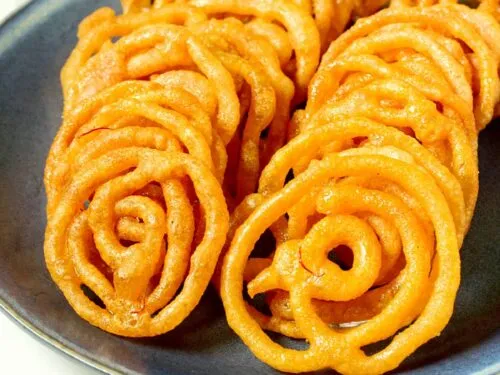
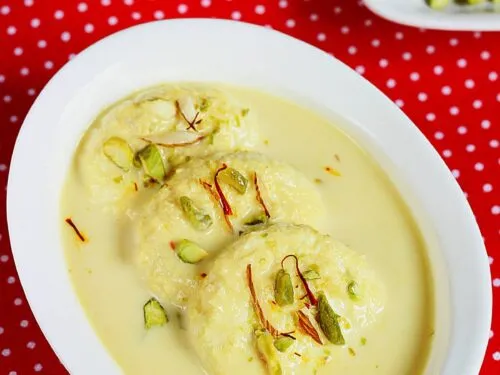
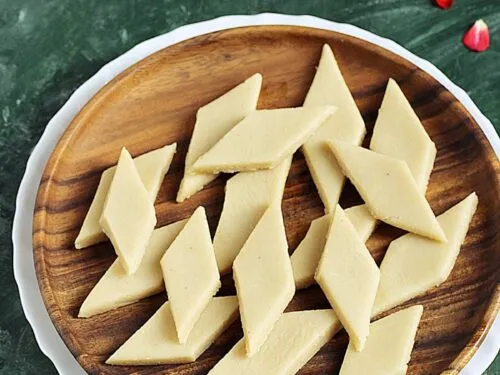
Comments
Amazing recipe
I am making Rabri and by mistake I have added sugar in the beginning itself. Will that make any difference to the texture
It may turn darker in color and have to stir more often.
How much rabdi will you appox get when you make 1× of the recipe
I guess around 600 Ml. It depends on the kind of milk used.
Hi swasthi, your recipes are my go-to and always turn out great! One question about this one- can this be used as a recipe for kulfi, just put in a mold and freeze it? Anything should be added or will it work as is?
Hi Devi,
Thank you. Yes you can use it. Grind about 18 to 20 pistachios in a grinder and add it during the last 5 mins of simmering. I have a similar recipe for kulfi here. Hope this helps.
?. Love this!
Thanks Prema
Eggless cake recipe is amazing..love ur all recipes
Thank you Seema
Your recipes are easy to understand and follow….They turn out good too…I follow you for anything I want to cook … Thanks for making life a bit easy…
Welcome Puja
Thanks for following
i liket your recipes
I love the way you explain and show in videos its awesome and looks so easy to do i have tried no of your recipes and they all turn out wow…
Thank you so much Archana!
Glad you like the recipes!
Ma’am
Cream is not sticking to the sides
I am using non stick kadhai
Jyoti,
You can still continue to cook. Even if it doesn’t stick that’s fine. Keep stirring to prevent burning
Yes ma’am
I made the rabri n came out really gud.
Actually will make sahi tukda in d evening so did half d work.
Plz tell me one more thing that bread i have to dip in syrup.
How sweet that syrup should be??
I mean would d dish will taste very sweet as rabri is so the bread will be too??
Thanks for trying Jyoti. Shahi tukda on the whole is very sweet and rich. You can actually skip soaking in the syrup. Instead fry the bread and directly pour the rabri over them. It will be fine. The sugar syrup will be of 1 string consistency so not very sweet. Both ways it will be good.